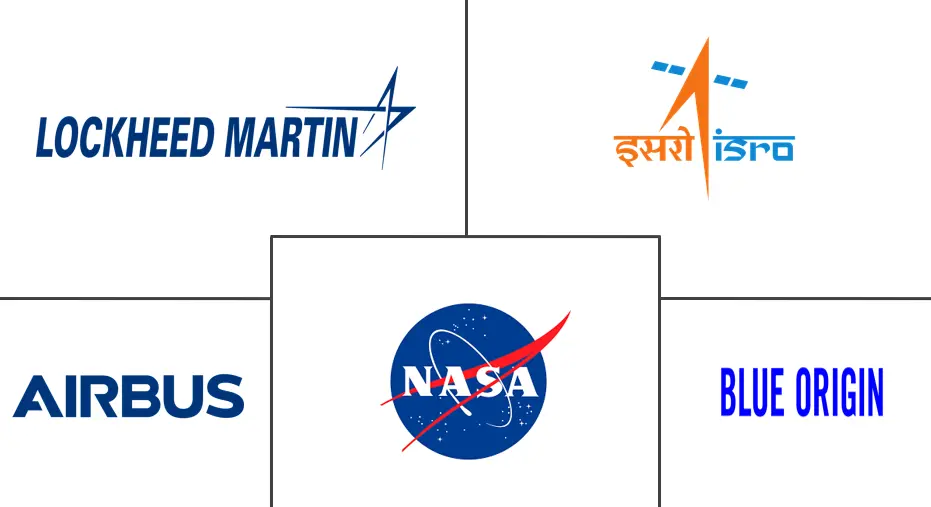Space Lander And Rover Market Size and Share
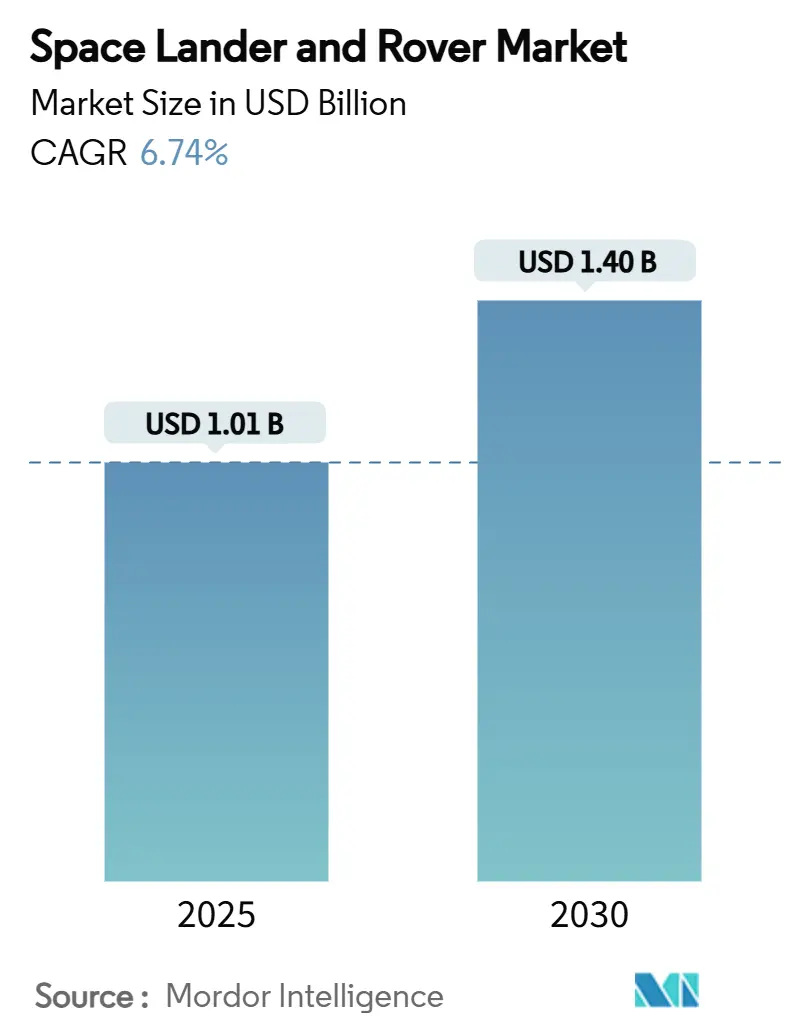
Space Lander And Rover Market Analysis by Mordor Intelligence
The space lander and rover market size stands at USD 1.01 billion in 2025 and is forecasted to reach USD 1.40 billion by 2030, advancing at a 6.74% CAGR. Solid government budgets, a surge of commercial partnerships, and rapid progress in autonomous navigation keep the space lander and rover market on an upward path. Momentum from NASA’s Artemis program, China’s parallel lunar plans, and ESA’s commitment to launch ExoMars Rosalind Franklin in 2028 underpin demand. Medium-class platforms anchor revenue today, yet micro systems are scaling quickly as miniaturization trims launch mass and cost. Meanwhile, hopper and legged vehicles extend surface reach, and fuel-cell power systems gain traction where sunlight is scarce. Commercial firms now win fixed-price delivery contracts, lowering cost barriers and widening mission cadence.
Key Report Takeaways
- By target body, lunar missions held 46.21% of the space lander and rover market share in 2024; asteroid and comet exploration is projected to expand at a 10.43% CAGR through 2030.
- By platform mass class, the medium segment led with 31.55% revenue share in 2024, while micro platforms are poised for an 8.67% CAGR to 2030.
- By mobility type, wheeled systems accounted for 47.43% of the space lander and rover market size in 2024, whereas hopper landers recorded the fastest growth at 8.21% CAGR.
- By power source, solar arrays dominated with a 56.20% share in 2024; fuel-cell solutions are advancing at a 10.01% CAGR through 2030.
- By end user, government agencies commanded 62.00% share in 2024, yet commercial players register the highest 9.89% CAGR.
- By geography, North America controlled 32.87% of 2024 revenue; Asia-Pacific is set to grow at an 8.58% CAGR on the strength of Chinese and Indian lunar programs.
Global Space Lander And Rover Market Trends and Insights
Drivers Impact Analysis
| Driver | ( ~ ) % Impact on CAGR Forecast | Geographic Relevance | Impact Timeline |
|---|---|---|---|
| Expansion of globally coordinated lunar exploration initiatives | +1.8% | Global (US, China, Europe) | Medium term (2-4 years) |
| Growing planetary science investments and mission pipeline | +1.2% | North America and EU, expanding to APAC | Long term (≥ 4 years) |
| Technological advancements in ultra-lightweight rover materials | +0.9% | Global, led by advanced manufacturing hubs | Medium term (2-4 years) |
| Acceleration of in-situ resource utilization (ISRU) testbed missions | +0.7% | Moon-focused regions | Long term (≥ 4 years) |
| Emergence of commercial payload sponsorship and rideshare models | +0.6% | North America core, expanding globally | Short term (≤ 2 years) |
| Rising demand for autonomy-driven terrain navigation and hazard avoidance | +0.5% | Global | Medium term (2-4 years) |
| Source: Mordor Intelligence | |||
Expansion of Globally Coordinated Lunar Exploration Initiatives
Forty-seven nations have signed the Artemis Accords, standardizing surface protocols and enabling interoperable rovers serving multiple stakeholders.[1]“Artemis Accords Fact Sheet,” NASA, nasa.gov China aims to place astronauts on the Moon by 2030, paired with Chang’e 7 and Chang’e 8, and create a parallel infrastructure that multiplies vehicle demand. The LUPEX mission by ISRO and JAXA shows how combining budgets delivers a 250 kg class rover that neither agency would field alone. ESA’s Heracles concept, staged from the Lunar Gateway, adds multi-agency cargo runs that require rugged autonomous vehicles. These coalitions shift procurement from bespoke one-off craft to modular fleets suited for diverse payloads.
Growing Planetary Science Investments and Mission Pipeline
NASA’s planetary science budget surpasses USD 3 billion annually, and ESA secures EUR 2.7 billion (USD 3.19 billion) for exploration through 2030. A dense manifest now includes low-cost Mars missions at USD 300 million each, China’s Tianwen-2 asteroid return in 2025, ESA’s Ramses mission to Apophis in 2028, and Japan’s MMX visit to Martian moons. The commercial lunar payload services program funnels USD 2.6 billion in fixed-price contracts to private lander firms, encouraging standardized rover frames that are easily tailored for individual payloads. Continuous launches stabilize production lines and shorten learning curves, propelling the space lander and rover market.
Technological Advancements in Ultra-Lightweight Rover Materials
New composites cut chassis mass by up to 40% without sacrificing strength. Carbon-nanotube structures and aerogel insulation broaden temperature tolerance to –230 °C-120 °C. NASA’s C-103 niobium and ToughMet alloys raise heat resilience for reusable fittings. Additive manufacturing with processed lunar regolith was demonstrated in 2024, reducing Earth-launched mass by 60%. Weight savings open the micro-platform niche and support rideshare launches, widening participation in the space lander and rover market.
Acceleration of In-Situ Resource Utilization (ISRU) Testbed Missions
The Perseverance rover’s MOXIE unit produced oxygen on Mars in 2024, confirming on-site life-support potential. Lunar rovers now integrate drills and reactors that extract water ice and oxygen, laying the groundwork for propellant depots. 3D-printing attachments can turn regolith into landing pads or shelter walls, pivoting vehicles from pure science to infrastructure roles. Commercial builders such as Lunar Outpost position ISRU rovers as revenue generators, expanding the space lander and rover industry beyond exploration to resource development.
Restraints Impact Analysis
| Restraint | ( ~ ) % Impact on CAGR Forecast | Geographic Relevance | Impact Timeline |
|---|---|---|---|
| Escalating R&D costs and frequent schedule delays | -0.8% | Global, high-complexity missions | Short term (≤ 2 years) |
| Limited planetary-launch windows and capacity | -0.6% | Global | Long term (≥ 4 years) |
| Strict planetary protection and biocontamination compliance | -0.5% | Global, with stricter enforcement in Mars missions | Medium term (2-4 years) |
| Thermal and radiation shielding challenges in extreme environments | -0.4% | Outer solar system and polar regions primarily | Long term (≥ 4 years) |
| Source: Mordor Intelligence | |||
Escalating R&D Costs and Frequent Schedule Delays
NASA’s Mars Sample Return program grew to USD 11 billion and now faces an undefined launch date. ESA’s ExoMars rover was re-scoped after losing Russian hardware, adding years to the calendar. Advanced autonomy, radiation shielding, and deep-drill systems raise qualification hurdles, while smaller firms underestimate planetary certification demands. Cost overruns force agencies to trim flight opportunities, tempering potential gains for the space lander and rover market.
Limited Planetary-Launch Windows and Capacity
Mars transfer windows open every 26 months; heavy-lift launches cost upward of USD 100 million and remain tightly booked. Payload sterilization adds months of lead time, and conflicts arise when multiple missions target the same trajectories. Tight cycles restrict cadence no matter how many rovers are ready, capping realizable growth.
Segment Analysis
By Target Body: Lunar Missions Drive Revenue While Asteroid Projects Surge
Lunar programs contributed 46.21% of the space lander and rover market share in 2024. Continued Artemis surface sorties, Chang’e cargo runs, and commercial payload deliveries anchor spending. However, asteroid and comet projects deliver the fastest 10.43% CAGR to 2030 as small-body sampling feeds science and resource appraisal. Mars missions hold steady with Perseverance and the 2028 ExoMars lander, while outer-solar-system concepts such as Enceladus rovers appear in agency roadmaps. Broader celestial coverage diversifies the space lander and rover market and underpins its long-term stability.
Growing interest in planetary defense also promotes asteroid rovers that map composition and internal structure. The success of the OSIRIS-REx sample return spurs more reconnaissance craft. Europa and Enceladus become reachable as nuclear power and autonomy mature, extending the addressable market into icy-moon environments that demand new thermal designs.
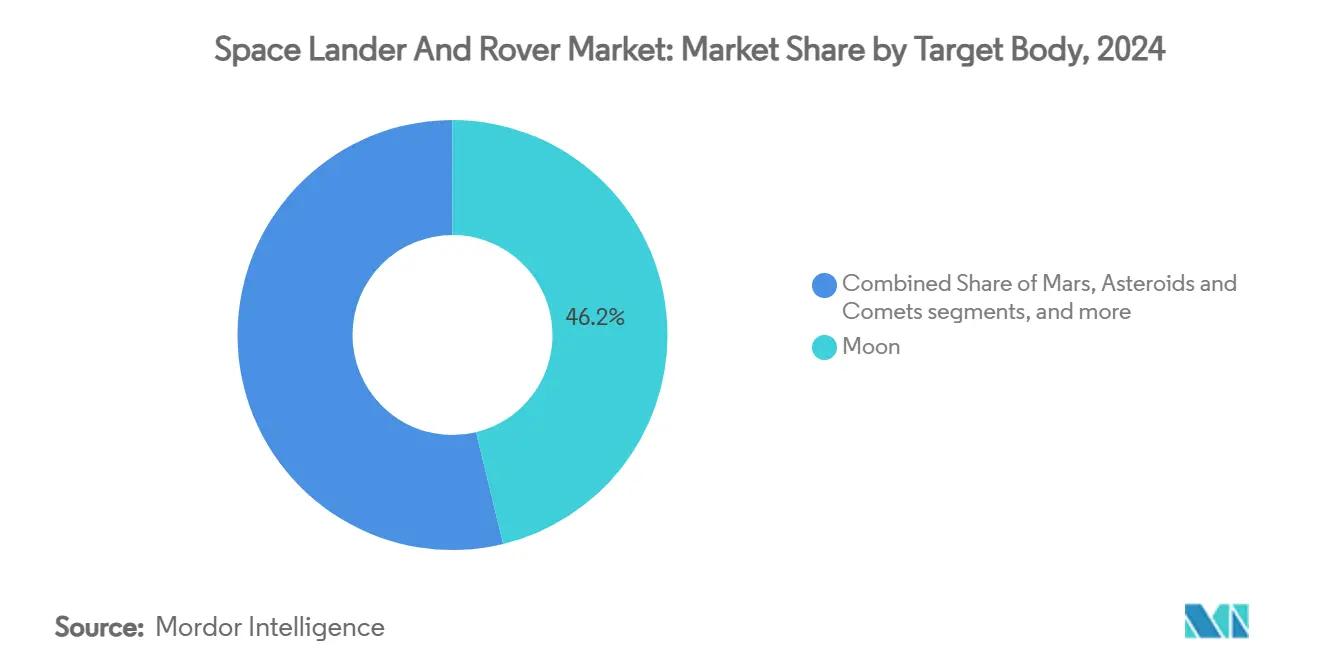
Note: Segment shares of all individual segments available upon report purchase
By Platform Mass Class: Medium Units Prevail as Micros Scale Fast
Medium craft held 31.55% of 2024 revenue, balancing payload capacity against launch price. Perseverance exemplifies their endurance and laboratory-grade instruments. At the same time, micro platforms post an 8.67% CAGR by leveraging miniaturized sensors and shared rides. Swarms of sub-100 kg rovers provide redundancy and broad terrain coverage, reshaping mission architecture toward distributed networks.
Small and heavy categories fill niche roles. Small systems scout landing zones, while heavy flagships carry deep drills or ISRU reactors. Yet advances in lightweight alloys mean tasks once reserved for 800 kg vehicles can migrate to 200 kg frames. That shift lowers overall mission cost and enlarges the pool of operators entering the space lander and rover market.
By Mobility Type: Wheels Dominate as Hoppers Open New Ground
Wheeled designs delivered 47.43% of the space lander and rover market size in 2024, buoyed by a proven rocker-bogie suspension that tackles moderate slopes. Propelled by controlled ballistic hops, Hopper craft registers an 8.21% CAGR. They reach crater rims and lava tubes without complex climbing actuators. Legged concepts, including quadrupeds with wheel-leg hybrids, progress from labs to field tests, promising better footing on boulder fields.
Tracked carriers and hybrid formats round out options where load distribution or adaptability outweigh speed. Flexibility in locomotion lets agencies match terrain with vehicle style, promoting platform diversity and fueling competitive differentiation across the space lander and rover market.
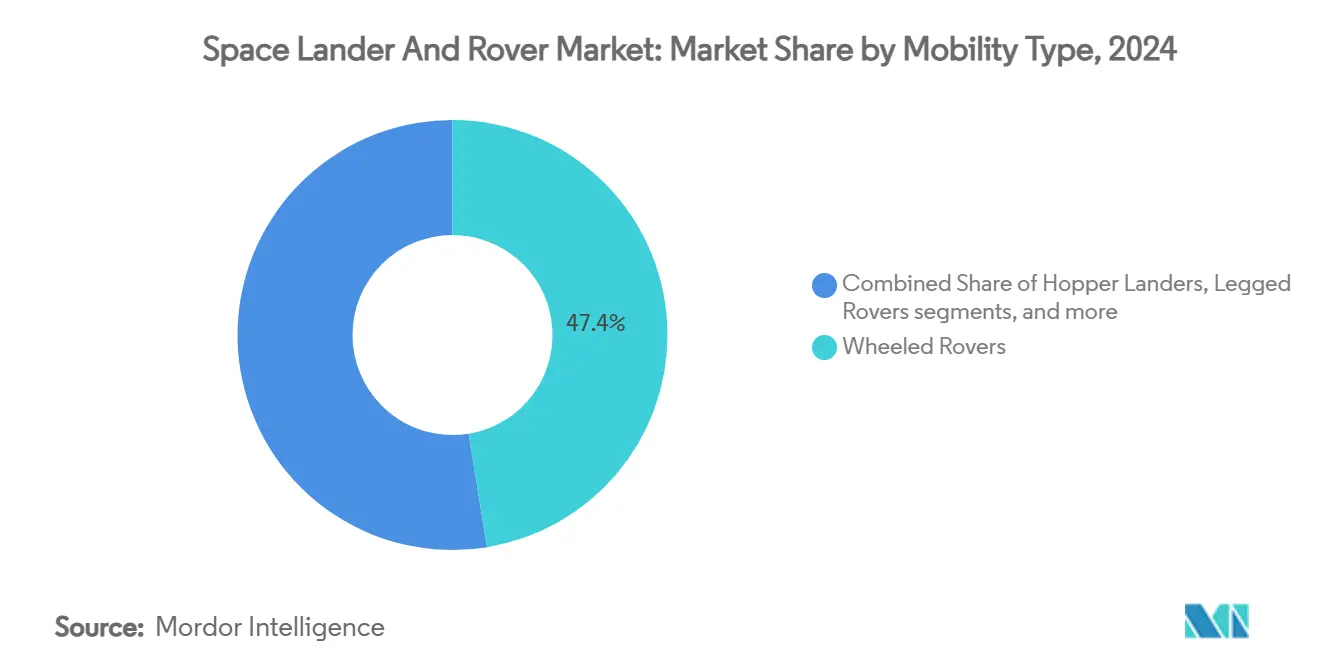
Note: Segment shares of all individual segments available upon report purchase
By Power Source: Solar Leads, Fuel-Cells Catch Up
Solar panels supplied 56.20% of 2024 revenue, with >30% efficient multi-junction cells toughened for dust and thermal cycles. Yet shadowed craters and 14-day lunar nights drive a 10.01% CAGR for fuel cells, which store reactants and run continuously. Regenerative hydrogen-oxygen stacks are under trial for Artemis surface ops and promise multi-mission reuse. RTGs remain indispensable for outer-planet journeys, and new Americium-241 units extend supply security. Battery-only packs serve quick sorties and act as contingency reserves.[2] “Americium-241 RTG Status Report,” NASA, nasa.gov
Hybrid architectures blend solar, RTGs, and batteries, ensuring fail-safe operations. Diverse power options extend mission latitude, expanding the space lander and rover market into deeper and darker destinations.
By End User: Government Keeps Lead, Commercial Grows Fast
Government agencies held 62.00% of 2024 revenue, funded by steady public budgets. However, the Commercial Lunar Payload Services framework pushes private firms toward a 9.89% CAGR. Companies such as Astrobotic and Intuitive Machines offer standardized landers that host multiple rover customers on fixed-price flights. Research universities ride these buses with niche instruments, while defense departments test reconnaissance payloads for cislunar awareness.
The symbiosis widens mission queues and reallocates risk. As private capital funds hardware alongside public grants, the space lander and rover market gains resilience against policy swings. Fixed-price service contracts have replaced many cost-plus agreements. Commercial providers front development capital, recouping investment over repeat flights. The result is launch cadence acceleration, lower per-mission expense, and a bigger pipeline of payloads. Governments still direct policy and own strategic objectives, but private operators supply the hardware at industrial scale, reinforcing the virtuous cycle of demand and capacity in the space lander and rover market.
Geography Analysis
North America commanded 32.87% of 2024 revenue thanks to NASA’s USD 3 billion-plus planetary science line and a dense cluster of prime contractors.[3]“NASA Planetary Science Budget FY 2025,” NASA, nasa.gov Integrated supply chains, test ranges, and regulatory clarity shorten development loops. SpaceX Starship, Blue Origin New Glenn, and ULA Vulcan boost lift capacity, enabling heavier rovers and aggregated payload classes that widen program options.
Europe secures second place on the strength of ESA’s EUR 2.7 billion (USD 3.19 billion) exploration envelope and forthcoming ExoMars liftoff in 2028.[4]“ESA ExoMars Status Update,” ESA, esa.int Airbus, Thales Alenia Space, and OHB supply propulsion, avionics, and structures. The region blends scientific rigor with sustainability aims, accelerating reusable lander stages and low-contamination sampling gear. Inter-agency collaboration remains Europe’s hallmark, drawing in Canada and Japan to share cost and expertise.
Asia-Pacific posts the fastest 8.58% CAGR. China’s dual-launcher cadence underpins Chang’e and Tianwen missions, while its planned 2030 crewed landing drives procurement of heavy lunar rovers. India’s ISRO scales Chandrayaan heritage into the LUPEX drill rover with JAXA, and Japan’s MMX mission illustrates multi-body reach. Emerging space startups contribute cost-efficient components, reshaping supply dynamics for the space lander and rover market.
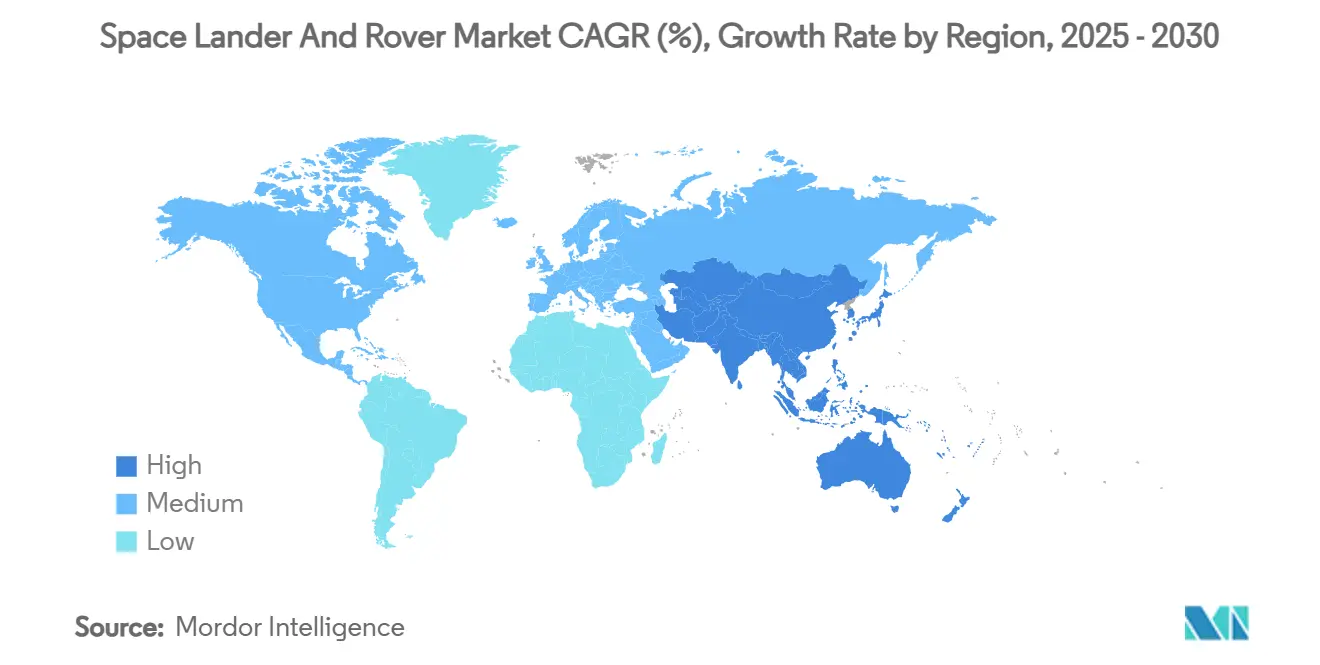
Competitive Landscape
The space lander and rover market is moderately concentrated, where heritage aerospace primes coexist with nimble newcomers. NASA, ESA, CNSA, and ISRO set technical baselines and mission needs. Lockheed Martin Corporation, Northrop Grumman, and Airbus SE leverage decades of flight heritage to secure large system contracts. Against them, Astrobotic, Intuitive Machines, iSpace, Inc., and Lunar Outpost commercialize modular landers and micro rovers under fixed-price terms, widening customer access.
Strategic alliances, rather than head-to-head fights, dominate. The Commercial Lunar Payload Services cohort teams with NASA on payload integration, while ISRO and JAXA share LUPEX responsibilities. Artificial intelligence is an emerging differentiator; JPL’s onboard machine-learning routines for Perseverance automate hazard avoidance and sample triage. Start-ups emphasize autonomy to offset limited ground control budgets, positioning software prowess as a route to market share. Standardized chassis and reusable propulsion units further shrink costs, encouraging procuring fleets rather than single craft and broadening the space lander and rover market customer base.
Space Lander And Rover Industry Leaders
-
National Aeronautics & Space Administration (NASA)
-
Lockheed Martin Corporation
-
Airbus SE
-
Blue Origin Enterprises, L.P.
-
Indian Space Research Organisation (ISRO)
- *Disclaimer: Major Players sorted in no particular order
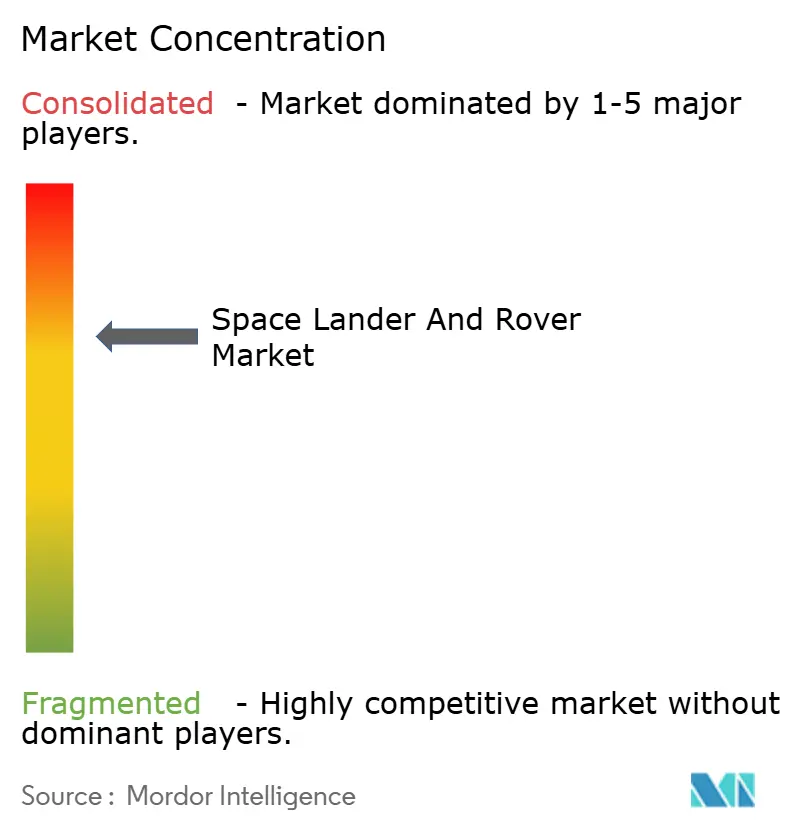
Recent Industry Developments
- March 2025: The European Space Agency (ESA) and Thales Alenia Space selected Airbus to develop critical systems for the ExoMars lander. The lander will transport the Rosalind Franklin rover to the surface of Mars.
- January 2025: Thales Alenia Space secured an EUR 862 million (USD 1,015 million) contract with the European Space Agency (ESA) to develop the Argonaut Lunar Lander for cargo delivery. The contract encompasses the design, development, and delivery of the Lunar Descent Element (LDE), mission design, and integration responsibilities.
Global Space Lander And Rover Market Report Scope
A lander is a spacecraft that descends toward and comes to rest on the surface of an astronomical body. Landers are designed and developed to make soft landings. A space rover is a planetary surface exploration device designed to move across the solid surface of a planet or other planetary-mass celestial bodies.
The space lander and rover market is segmented by type and geography. By type, the market is segmented into lunar surface exploration, Mars surface exploration, and asteroid surface exploration. The report also covers the sizes and forecasts for the space lander and rover market in major countries across different regions. For each segment, the market size is provided in terms of value (USD).
| Moon |
| Mars |
| Asteroids and Comets |
| Other Celestial Bodies |
| Micro |
| Small |
| Medium |
| Heavy |
| Wheeled Rovers |
| Hopper Landers |
| Legged Rovers |
| Tracked Rovers |
| Hybrid Mobility Platforms |
| Solar |
| Radioisotope Thermoelectric Generator |
| Fuel-Cell |
| Battery-Only |
| Government Space Agencies |
| Commercial Space Companies |
| Research Institutions and Universities |
| Defense Agencies |
| North America | United States | |
| Canada | ||
| Mexico | ||
| Europe | United Kingdom | |
| Germany | ||
| France | ||
| Italy | ||
| Rest of Europe | ||
| Asia-Pacific | China | |
| India | ||
| Japan | ||
| South Korea | ||
| Rest of Asia-Pacific | ||
| South America | Brazil | |
| Rest of South America | ||
| Middle East and Africa | Middle East | United Arab Emirates |
| Saudi Arabia | ||
| Rest of Middle East | ||
| Africa | South Africa | |
| Rest of Africa | ||
| By Target Body | Moon | ||
| Mars | |||
| Asteroids and Comets | |||
| Other Celestial Bodies | |||
| By Platform Mass Class | Micro | ||
| Small | |||
| Medium | |||
| Heavy | |||
| By Mobility Type | Wheeled Rovers | ||
| Hopper Landers | |||
| Legged Rovers | |||
| Tracked Rovers | |||
| Hybrid Mobility Platforms | |||
| By Power Source | Solar | ||
| Radioisotope Thermoelectric Generator | |||
| Fuel-Cell | |||
| Battery-Only | |||
| By End User | Government Space Agencies | ||
| Commercial Space Companies | |||
| Research Institutions and Universities | |||
| Defense Agencies | |||
| By Geography | North America | United States | |
| Canada | |||
| Mexico | |||
| Europe | United Kingdom | ||
| Germany | |||
| France | |||
| Italy | |||
| Rest of Europe | |||
| Asia-Pacific | China | ||
| India | |||
| Japan | |||
| South Korea | |||
| Rest of Asia-Pacific | |||
| South America | Brazil | ||
| Rest of South America | |||
| Middle East and Africa | Middle East | United Arab Emirates | |
| Saudi Arabia | |||
| Rest of Middle East | |||
| Africa | South Africa | ||
| Rest of Africa | |||
Key Questions Answered in the Report
What is the current value of the space lander and rover market?
The space lander and rover market size is USD 1.01 billion in 2025 and is projected to reach USD 1.40 billion by 2030.
Which celestial target dominates rover demand today?
Lunar missions account for 46.21% of 2024 revenue, driven by Artemis, Chang’e, and commercial payload programs.
Which mobility technology is growing the fastest?
Hopper vehicles post the highest 8.21% CAGR because they can leap over rough terrain that wheels cannot traverse.
Why are fuel-cells gaining attention for planetary rovers?
Fuel-cells provide continuous power during long lunar nights or in shadowed craters where solar arrays are ineffective, supporting a 10.01% CAGR in their adoption.
How big is the commercial segment compared with government users?
Government agencies still hold 62.00% share, but commercial operators are expanding rapidly at a 9.89% CAGR thanks to fixed-price payload delivery contracts.
Which region is expected to grow the quickest?
Asia-Pacific records an 8.58% CAGR on the strength of Chinese, Indian, and Japanese exploration initiatives.
Page last updated on:
